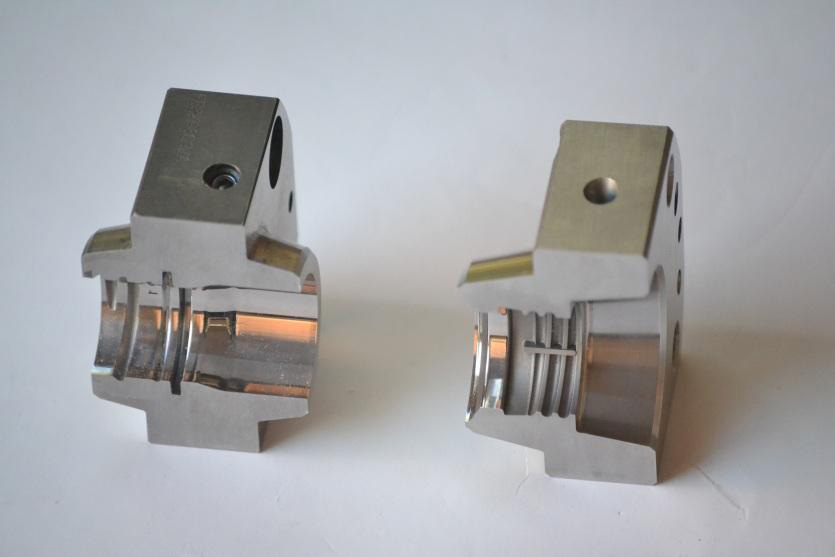Parison Molds
Individual parison mold blocks are normally fabricated from 1017 HRS or P-20 pre-hard steel for use with polyolefin molding resins. Molds for rigid resins, such as styrenics, nitriles, carbonates, etc.” are usually made of an oil-hardening steel (A-2 or equivalent), rough machined and hardened to RC 40-45. In both cases final polishing is usually followed by hard chroming of the molding surfaces, although this is not required for polyolefin molds.
Cooling lines for control of cavity temperature are placed close to the surface. The use of O-rings between adjacent cavities is standard practice.No venting is used on the parison mold parting line. If required, the venting is over the core rod and out the back of the mold.
Neck rings are separate inserts, as shown in Fig, 2. Construction is normally of oil-hardening steel (A-2 type) with hardening to RC 54-56 for all resin types.

Fig, 2.
Nozzles seat directly into the parison bottom mold, with the top half of the parison mold clamping and unclamping with every cycle. Mold flash, if it occurs, is most probably at the nozzle, with potential nozzle or nozzle seat hobbing. Practice varies widely on nozzle hardness, but replaceable nozzle seats as shown in Fig. 11.48 D are in wide use. This eliminates the need for enlarging the nozzle seat with time and stocking nozzles of various diameters.
Blow Molds for Rigid Plastics
Blow molds for rigid plastics such as the styrene compounds, nitriles, etc., are of turned or hobbed steel. Generally, air-hardening steel is preferred, such as A-2 type. Hardening is normally to RC 45-50,followed by polishing and hard chroming. Unless the container is virtually flat-based (.030 in. push-up or less) then a retractable base push-up must be used. Neck rings are also of hardened steel, polished and chromed. Overall shrink factor for the non-crystalline resins is .005 in./in. in both directions.

Blow Mold Design for PVC
Even though PVC is a rigid plastic, some change in mold design must be made to accommodate its special characteristics of corrosiveness and very poor heat transfer.Current practice is to use suitably hardened BeCu blow molds. Aluminum molds will rapidly deteriorate; chrome plate will peel from steel molds because the steel corrodes under the chrome; and stainless steel imposes a time penalty on cycles because of its inferior heat transfer properties.
The alignment of a blow mold for PVC is critical because of its low strength when subjected to the notched Izod impact test. Any misalignment between the mold halves will create a step-notch on the molded part, which will adversely affect the drop impact strength of the container. For this reason, block-style molds are often used for PVC instead of the individual cavities employed in molds for other plastics.
Molds for PVC parisons are usually made from 400 series stainless steel and hardened, because it has proven more satisfactory than chrome-plated steel. Conversely, stainless-steel core rods have proven less satisfactory than tool-steel core rods which have received nickel/chrome plating or just nickel plating.
PVC shrinkage is relatively low (.006-.007 in./in.) and is quite predict-able. To eliminate sinks in the thread profile, the thread is narrowed to create a more uniform cross-section. “L,,style threads are to be avoided if possible. The explanation for this ability to narrow the thread profile is that thread profiles for plastic bottles were set in the early 1960s with polyethylene in mind. The higher-strength plastics, such as PVC, do not require such massive profiles.
The manifold contour must cause the melt to be distributed uniformly. The critical elements in the design are flow pattern, temperature, and residence time of the melt. For ease of manufacture and for ease in disassembly for cleaning, manifolds are split into sections. The split can be either vertical or horizontal to give access for the cutting and shaping of the flow channel(s).
